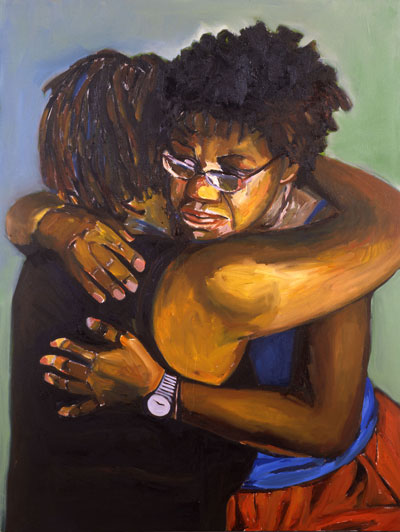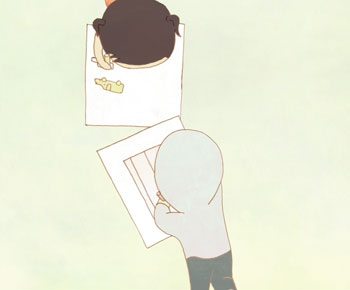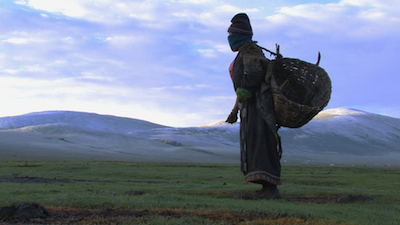“Raising Renee” begins in 2003 as Beverly McIver is savoring opening night of her first solo art show in New York. A talented painter and winner of major awards, her career was skyrocketing. She flew in her mother Ethel, a maid from Greensboro, North Carolina and her sister Renee, 43, who is mentally disabled and functions at about the level of a third grader. Years before, Beverly had casually promised her mother that she would take Renee when Ethel died, an event that seemed infinitely far off and unlikely to impinge on her life as a single black woman, painting and teaching where her work took her. But in 2004, Ethel died suddenly and Beverly’s promise was put to the test. “Raising Renee” is the story of a family’s remarkable response to being broken apart and rearranged after nearly 50 years. The film explores deep themes of family, race, class and disability through the interplay of painting, cinema and everyday life. Produced and directed by Jeanne Jordan and Steven Ascher, “Raising Renee” is the third part in a trilogy about resilient families that includes their acclaimed feature documentaries SO MUCH SO FAST and the Oscar-nominated, Sundance Grand Jury Prize winner “Troublesome Creek: a Midwestern”.Beverly McIver grew up in the 1960’s and 70’s in a housing project in Greensboro, North Carolina. Ethel singlehandedly raised her and her two sisters, working as a maid for white families. Segregation in Greensboro was notorious – it was the site of the earliest student sit-ins of the civil rights movement. A 1979 rally against the Ku Klux Klan in front of the McIvers’ house resulted in five people shot dead by the Klan.Beverly’s talent brought her out of this world and into the world of art and a tenured professorship. It’s stunning to see the dream of upward mobility played out in one generation, and to look at its costs and implications. Beverly’s work has been politically controversial, examining racial and sexual stereotypes and executed in a style that critic Irving Sandler calls a merger of “personal confession and social commentary, photography and painting, and realism and expressionism.”The narrative arc of “Raising Renee” takes us from the time when Ethel and Renee shared a home in Greensboro, through Ethel’s illness and death, then to the pivotal moment in 2004 when Beverly brought Renee to live with her in Phoenix, Arizona. Viewers experience the consequences of Beverly’s promise to “raise” her sister, a forty-three-year-old woman/child, and the way it transforms her life at a time when she had hoped to focus on her burgeoning career and on finding a life partner.Renee, who had lived with her mother from birth, undergoes an even greater transformation. At times she seems childlike; at others times she is surprisingly competent and articulate. She, too, is an artist, creating a large output of potholders and crafts. In the fall of 2009, after living with Beverly for five years, an opportunity arose for her to live independently – something that was unthinkable when their mother was alive. How she responds to this challenge at age 50 is astonishing, and poses key questions about disability and ability.In “Raising Renee” events unfold over six years with humor, drama and unexpected twists, investing the film with the scope of a nonfiction novel that’s nearly impossible to put down. The film provides a deeply intimate view of a unique group of women, the tenacity of family bonds and the power of art to transform experience into something beyond words.
Summary info for schedule – will be hidden on film page

Raising Renee
81-minutes
Screening day / time
Raising Renee
Filmmaker(s)
Running Time
Genres
Raising Renee
Filmmaker Notes:
“Raising Renee” began with an offhand promise. In 2003, Jeannie was a fellow at the Radcliffe Institute for Advanced Study, working on our film, “So Much So Fast”. In the next studio was Beverly McIver, working on a set of paintings about her life. They developed a friendship and Beverly talked about the promise she’d casually made her mother Ethel that she’d take care of her mentally disabled older sister Renee if anything happened to Ethel. She was just starting to grasp what that might mean and pleaded jokingly for advice on how to get out of it.We were fascinated by Beverly, her talent as a painter, her instinctive storytelling—and the idea of her promise. Ethel, a maid in Greensboro, North Carolina who had cared for Renee for 43 years, was strong and healthy and no one had any idea of how the story would play out, but we started filming a few scenes while we worked on other projects.Six years later, the result is “Raising Renee”, a feature documentary that captures the McIver family’s saga of reinventing itself. The film is the third in our trilogy about remarkable families which includes TROUBLESOME CREEK: A MIDWESTERN (about the Jordan family, threatened with the loss of their Iowa farm) and SO MUCH SO FAST (about the Heywood family, threatened with the loss of their son to Lou Gehrig’s disease). All three films begin at a moment of crisis and take a longitudinal approach to uncover meanings that are only visible by filming over years, through an intimacy with our subjects forged by time.We approached each of these films with an eye toward plot and the inherent drama of everyday life. At first glance the storyline may seem deceptively straightforward. But embedded in it is an exploration of family relations, race and class in America, and intellectual disability. Audiences sometimes approach these issues with clichéd assumptions —assumptions we seek to upend with the unexpected complexity of actual life. Beverly’s gift to her sister can be seen as heroic, but the film is just as interested in the conflicted feelings that come with that gift, which gets closer to the true nature of heroism.”Raising Renee” is in part about the relationship of art-making and lived experience. Beverly’s work has focused on the swirling dynamics of love and tension with Renee and Ethel. Audiences see events as filmed by our camera and as interpreted in Beverly’s art, giving them a privileged position to examine the interactions of painting, life and film. Beverly’s canvases become another character in themselves. The three films in this trilogy were long-term commitments because we’re interested in time – time for our characters’ lives to unfold, and time to elucidate deep layers of interconnections through story, structure, image and sound.




